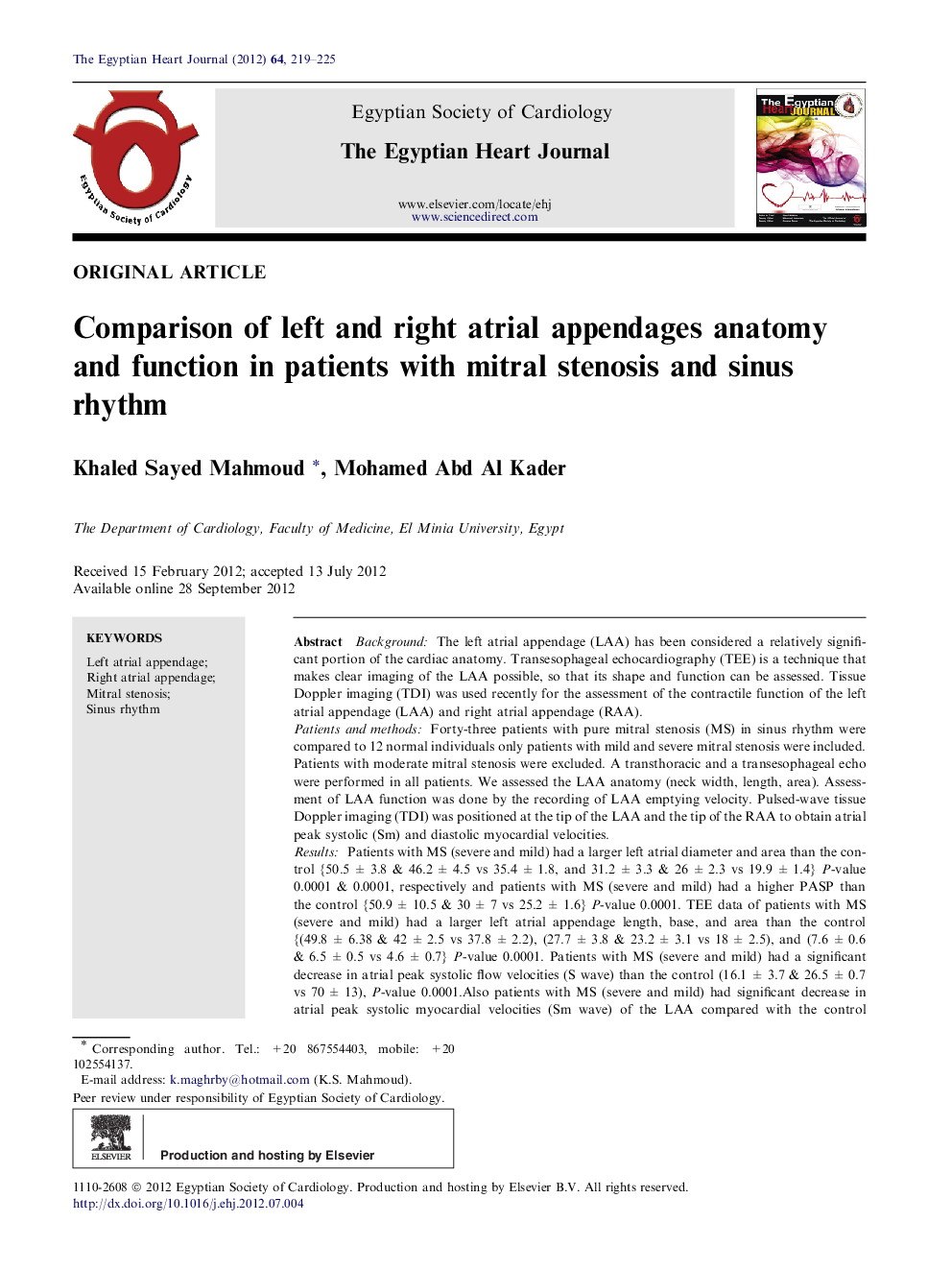| کد مقاله | کد نشریه | سال انتشار | مقاله انگلیسی | نسخه تمام متن |
|---|---|---|---|---|
| 2910635 | 1175021 | 2012 | 7 صفحه PDF | دانلود رایگان |

BackgroundThe left atrial appendage (LAA) has been considered a relatively significant portion of the cardiac anatomy. Transesophageal echocardiography (TEE) is a technique that makes clear imaging of the LAA possible, so that its shape and function can be assessed. Tissue Doppler imaging (TDI) was used recently for the assessment of the contractile function of the left atrial appendage (LAA) and right atrial appendage (RAA).Patients and methodsForty-three patients with pure mitral stenosis (MS) in sinus rhythm were compared to 12 normal individuals only patients with mild and severe mitral stenosis were included. Patients with moderate mitral stenosis were excluded. A transthoracic and a transesophageal echo were performed in all patients. We assessed the LAA anatomy (neck width, length, area). Assessment of LAA function was done by the recording of LAA emptying velocity. Pulsed-wave tissue Doppler imaging (TDI) was positioned at the tip of the LAA and the tip of the RAA to obtain atrial peak systolic (Sm) and diastolic myocardial velocities.ResultsPatients with MS (severe and mild) had a larger left atrial diameter and area than the control {50.5 ± 3.8 & 46.2 ± 4.5 vs 35.4 ± 1.8, and 31.2 ± 3.3 & 26 ± 2.3 vs 19.9 ± 1.4} P-value 0.0001 & 0.0001, respectively and patients with MS (severe and mild) had a higher PASP than the control {50.9 ± 10.5 & 30 ± 7 vs 25.2 ± 1.6} P-value 0.0001. TEE data of patients with MS (severe and mild) had a larger left atrial appendage length, base, and area than the control {(49.8 ± 6.38 & 42 ± 2.5 vs 37.8 ± 2.2), (27.7 ± 3.8 & 23.2 ± 3.1 vs 18 ± 2.5), and (7.6 ± 0.6 & 6.5 ± 0.5 vs 4.6 ± 0.7} P-value 0.0001. Patients with MS (severe and mild) had a significant decrease in atrial peak systolic flow velocities (S wave) than the control (16.1 ± 3.7 & 26.5 ± 0.7 vs 70 ± 13), P-value 0.0001.Also patients with MS (severe and mild) had significant decrease in atrial peak systolic myocardial velocities (Sm wave) of the LAA compared with the control (6.1 ± 1.7 & 12.6 ± 0.3 vs 18.8 ± 1.9), P-value 0.0001. (TDI) flow of the RAA myocardial velocity, patients with mitral stenosis (severe and mild) had a significant decrease in atrial peak systolic myocardial velocities (Sm wave) of the RAA compared with the control (16.5 ± 2.9 & 17.7 ± 1.6 vs 20.1 ± 2.6), P-value 0.0001. SEC was detected in the LAA in 17 patients of the 43 patients with mitral stenosis which represents 39.5% of the patients. All patients with SEC were with severe MS. Patients with SEC had a significant increase in Fc, mean transmitral gradient, PASP, Sm LAA, Sm RAA, LAA area and peak S velocity LAA than patients without SEC. No patient had SEC in the RAA cavity.ConclusionLAA and RAA dysfunction occurred in patients with MS and sinus rhythm due to increase of atrial afterload presented by a decrease in atrial myocardial velocities.
Journal: The Egyptian Heart Journal - Volume 64, Issue 4, December 2012, Pages 219–225